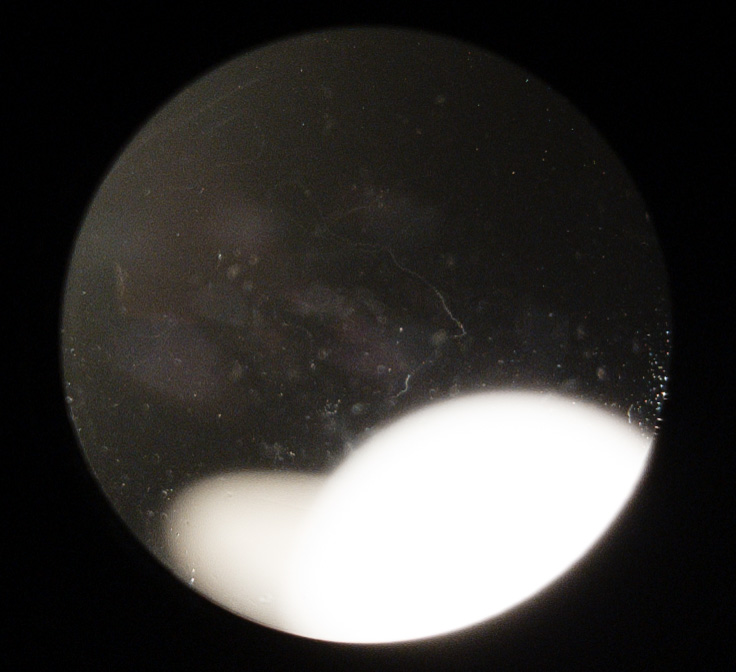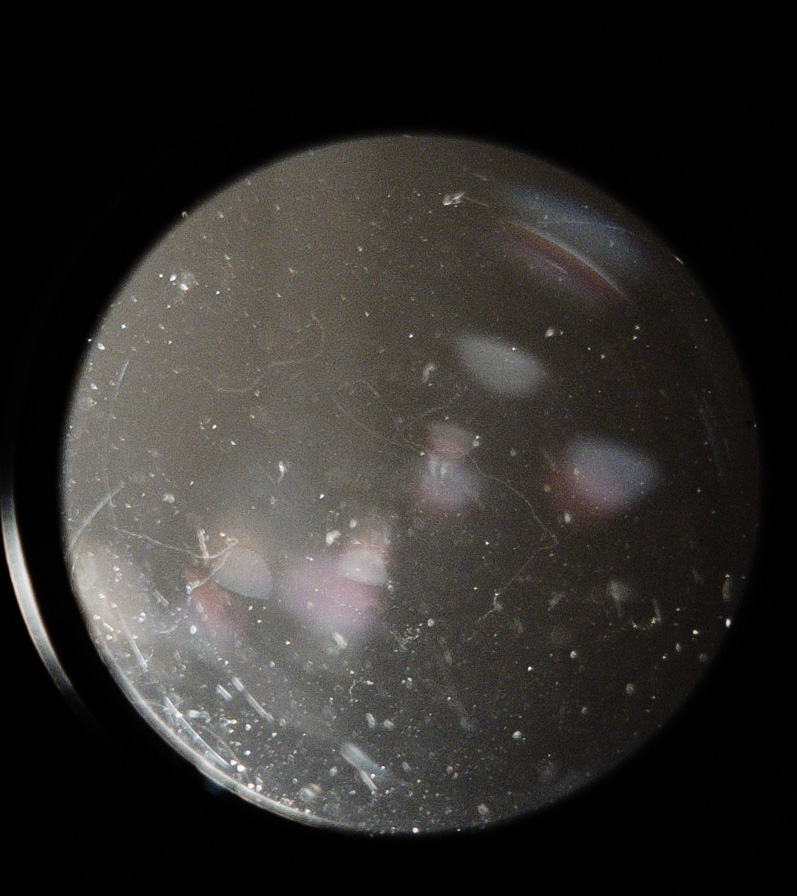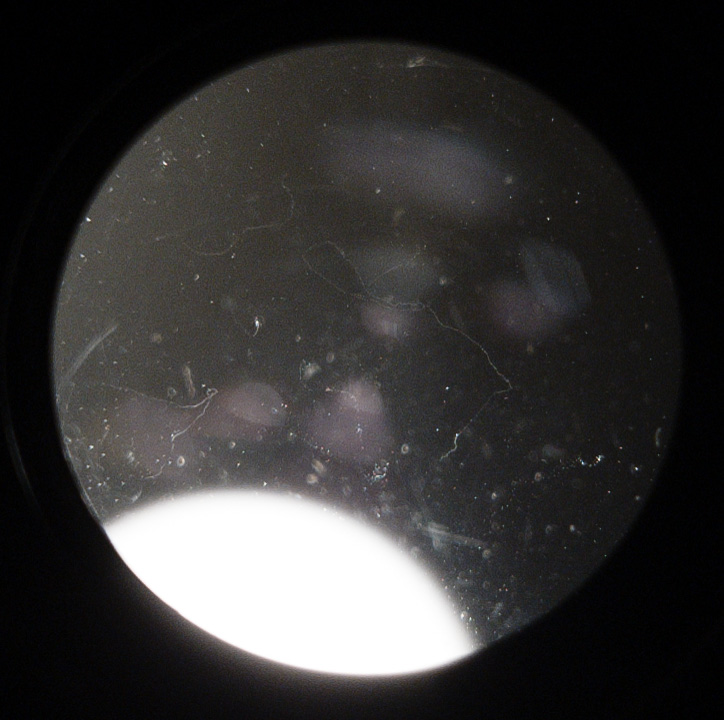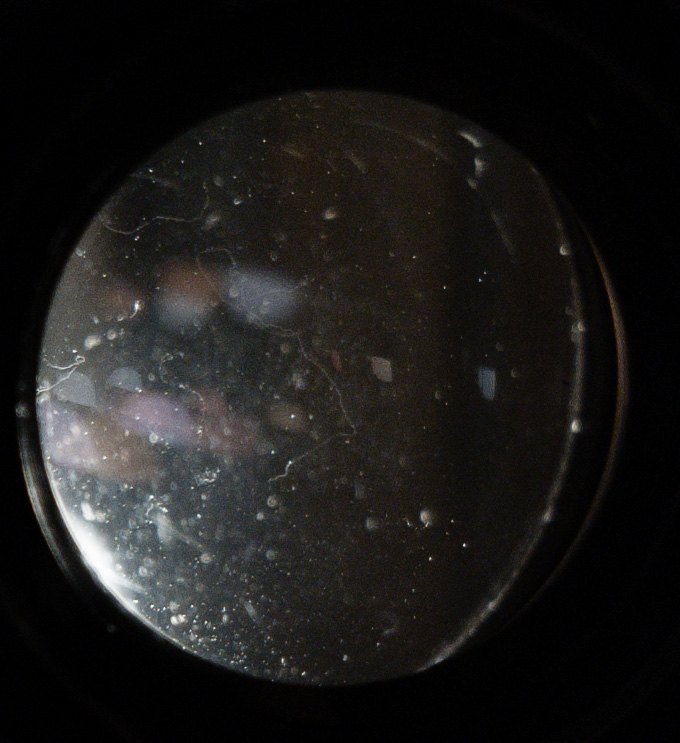| View previous topic :: View next topic |
| Author |
Message |
Fandyus

Joined: 12 Apr 2020
Posts: 108
Location: Czechia
|
 Posted: Thu Mar 25, 2021 4:59 pm Post subject: [Helios 44-2] Is this fungus? Posted: Thu Mar 25, 2021 4:59 pm Post subject: [Helios 44-2] Is this fungus? |
 |
|
Fandyus wrote:
A family friend just gifted me an old Zenit that I think his father used to own. The camera's shutter is stuck but the lens was near mint, I already tested it and it is perfectly centered and only shows some mild cosmetic signs of wear. The serial number is 81351584. There are however, some weird fibers inside.
#1

#2

#3

#4

Anyone know if this is fungus? Thanks. |
|
| Back to top |
|
 |
calvin83


Joined: 12 Apr 2009
Posts: 7574
Location: Hong Kong
|
 Posted: Thu Mar 25, 2021 5:22 pm Post subject: Posted: Thu Mar 25, 2021 5:22 pm Post subject: |
 |
|
calvin83 wrote:
I think so.
_________________
The best lens is the one you have with you.
https://lensfever.com/
https://www.instagram.com/_lens_fever/ |
|
| Back to top |
|
 |
Zamo

Joined: 08 Feb 2019
Posts: 168
|
 Posted: Thu Mar 25, 2021 5:34 pm Post subject: Posted: Thu Mar 25, 2021 5:34 pm Post subject: |
 |
|
Zamo wrote:
Looks like it. And it is very easy to disassemble and clean, if you dare doing that. |
|
| Back to top |
|
 |
Fandyus

Joined: 12 Apr 2020
Posts: 108
Location: Czechia
|
 Posted: Thu Mar 25, 2021 5:39 pm Post subject: Posted: Thu Mar 25, 2021 5:39 pm Post subject: |
 |
|
Fandyus wrote:
| calvin83 wrote: |
| I think so. |
thanks |
|
| Back to top |
|
 |
Fandyus

Joined: 12 Apr 2020
Posts: 108
Location: Czechia
|
 Posted: Thu Mar 25, 2021 5:42 pm Post subject: Posted: Thu Mar 25, 2021 5:42 pm Post subject: |
 |
|
Fandyus wrote:
| Zamo wrote: |
| Looks like it. And it is very easy to disassemble and clean, if you dare doing that. |
I was always afraid to try and do this since I'm afraid that I'll decenter the lens. Is it possible that that happens? Also what is the ideal thing to use to clean the suface? Isopropanol? Hydrogen peroxide? Just straight ethanol? |
|
| Back to top |
|
 |
Dejan


Joined: 05 Jan 2021
Posts: 149
Location: Belgrade, Serbia
|
 Posted: Thu Mar 25, 2021 10:26 pm Post subject: Posted: Thu Mar 25, 2021 10:26 pm Post subject: |
 |
|
Dejan wrote:
I've been cleaning Helios 44-2 lenses a few times and I've never encountered issues with the centering. The lens' construction is so simple that it's very easy to put the elements back in place. As long as you make sure the glass is in its proper place (and nothing is reversed) I've no doubt that everything will be OK. There aren't many parts inside so it should be easy to remember what goes where (and there are many fine tutorials to help). As for the chemicals, I'd start with the least aggressive one (sometimes even something like Fairy can be enough) and see what happens. I'd also wipe the inside of the lens with alcohol to prevent the fungus from coming back. |
|
| Back to top |
|
 |
Lloydy


Joined: 02 Sep 2009
Posts: 7794
Location: Ironbridge. UK.
Expire: 2022-01-01
|
 Posted: Thu Mar 25, 2021 11:48 pm Post subject: Posted: Thu Mar 25, 2021 11:48 pm Post subject: |
 |
|
Lloydy wrote:
It's a simple and robust lens. Fungus like that is usually easy to clean, I've used cold cream - the stuff people use to remove make up - with success. It has no strong solvents or chemicals and seems to dissolve the fungus. Just paste it on, let it soak for 15 minutes or so, and wash it off with dish soap and water.
_________________
LENSES & CAMERAS FOR SALE.....
I have loads of stuff that I have to get rid of, if you see me commenting about something I have got and you want one, ask me.
My Flickr https://www.flickr.com/photos/mudplugga/
My ipernity -
http://www.ipernity.com/home/294337 |
|
| Back to top |
|
 |
Zamo

Joined: 08 Feb 2019
Posts: 168
|
 Posted: Thu Mar 25, 2021 11:57 pm Post subject: Posted: Thu Mar 25, 2021 11:57 pm Post subject: |
 |
|
Zamo wrote:
Looks thin and probably comes out easily. I have used commercial (not too concentrated, that is) hydrogen peroxide and the fungus dissolves in 1-2 minutes. And, as said, you cannot decenter the glasses, they have their location where they fit tightly. |
|
| Back to top |
|
 |
cbass

Joined: 27 Jul 2019
Posts: 450
|
 Posted: Sat Mar 27, 2021 12:06 am Post subject: Posted: Sat Mar 27, 2021 12:06 am Post subject: |
 |
|
cbass wrote:
So for those knowledgeable on the subject I have some questions.
So how do lenses get decentered? Is it largely a product of the manufacturing process and thus usually you can't correct it?
Also, what is the purpose of a collimator?
I have read the following on another forum:
| Quote: |
When a lens is taken apart if the glass is held by rings ,and loose when the rings are eased, then it was collimated.
Some collimation was done out of the lens body, in glued up assemblies of several elements, and these are elements contained in a brass or metal tube as an assembly. Usually you do not loose collimation removing these. |
Source:
https://cameracollector.proboards.com/post/68643/thread
This implies that you can lose some optical performance unless you do collimation again especially if you remove the optical elements from an optical block.
Finally, I imagine this can't apply to aspherical lens elements? It's not an issue on this lens, but I am curious. With aspheric lens elements I would think the position matters. Is this not correct?
Also, look at the following article:
https://yukosteel.wordpress.com/2017/02/23/mitakon-zhongyi-35mm-f0-95-mark-ii-lens-disassembly-part-2/
| Quote: |
| NOTE: you can see the deep and rough paint scratch in the left border area. It’s intentional factory mark of the front lens group radial position. When assembling lens back remember to put it in the same way so two scratched marks fit. |
This implies that at least in some lenses the radial position matters. In this case it's for a whole optical group. What happens when you remove lenses from that optical group. I would think it would require optical calibration. |
|
| Back to top |
|
 |
visualopsins


Joined: 05 Mar 2009
Posts: 11027
Location: California
Expire: 2025-04-11
|
 Posted: Mon Mar 29, 2021 2:28 am Post subject: Posted: Mon Mar 29, 2021 2:28 am Post subject: |
 |
|
visualopsins wrote:
https://garyseronik.com/a-beginners-guide-to-collimation/
Mechanical construction, how elements are held in position, determines if decolimination can occur -- most modern lenses have precision-ground edges and mounts which prevent misalignment
Glued elements separated, on regluing can become decentered.
Aspheric elements are no different from non-aspheric; the radial differences do not cause decentering as those are along another axis.
Inaccuracies in curvature of elements require radial alignment to achieve colimination.
_________________
☮☮☮☮☮☮☮☮☮☮☮☮☮☮☮☮☮☮☮☮☮☮☮☮☮☮☮☮☮☮☮☮ like attracts like! ☮☮☮☮☮☮☮☮☮☮☮☮☮☮☮☮☮☮☮☮☮☮☮☮☮☮☮☮☮☮☮☮
Cameras: Sony ILCE-7RM2, Spotmatics II, F, and ESII, Nikon P4
Lenses:
M42 Asahi Optical Co., Takumar 1:4 f=35mm, 1:2 f=58mm (Sonnar), 1:2.4 f=58mm (Heliar), 1:2.2 f=55mm (Gaussian), 1:2.8 f=105mm (Model I), 1:2.8/105 (Model II), 1:5.6/200, Tele-Takumar 1:5.6/200, 1:6.3/300, Macro-Takumar 1:4/50, Auto-Takumar 1:2.3 f=35, 1:1.8 f=55mm, 1:2.2 f=55mm, Super-TAKUMAR 1:3.5/28 (fat), 1:2/35 (Fat), 1:1.4/50 (8-element), Super-Multi-Coated Fisheye-TAKUMAR 1:4/17, Super-Multi-Coated TAKUMAR 1:4.5/20, 1:3.5/24, 1:3.5/28, 1:2/35, 1:3.5/35, 1:1.8/85, 1:1.9/85 1:2.8/105, 1:3.5/135, 1:2.5/135 (II), 1:4/150, 1:4/200, 1:4/300, 1:4.5/500, Super-Multi-Coated Macro-TAKUMAR 1:4/50, 1:4/100, Super-Multi-Coated Bellows-TAKUMAR 1:4/100, SMC TAKUMAR 1:1.4/50, 1:1.8/55
M42 Carl Zeiss Jena Flektogon 2.4/35
Contax Carl Zeiss Vario-Sonnar T* 28-70mm F3.5-4.5
Pentax K-mount SMC PENTAX-A ZOOM 1:3.5 35~105mm, SMC PENTAX ZOOM 1:4 45~125mm
Nikon Micro-NIKKOR-P-C Auto 1:3.5 f=55mm, NIKKOR-P Auto 105mm f/2.5 Pre-AI (Sonnar), Micro-NIKKOR 105mm 1:4 AI, NIKKOR AI-S 35-135mm f/3,5-4,5
Tamron SP 17mm f/3.5 (51B), Tamron SP 17mm f/3.5 (151B), SP 500mm f/8 (55BB), SP 70-210mm f/3.5 (19AH)
Vivitar 100mm 1:2.8 MC 1:1 Macro Telephoto (Kiron)
|
|
| Back to top |
|
 |
cbass

Joined: 27 Jul 2019
Posts: 450
|
 Posted: Mon Mar 29, 2021 6:38 pm Post subject: Posted: Mon Mar 29, 2021 6:38 pm Post subject: |
 |
|
cbass wrote:
It looks like even on a Helios lens collimation can make a difference and there is some room for optical alignment.
This guy took what he knew to be a factory assembled Helios from 724 lp/mm to 769 lp/mm but he spent some time and had special equipment. Later in the thread he tries to do better aligning a MIR 35mm than the factory, but after 3 hours falls short.
| Quote: |
So, what that gives us concerning the from-the-factory optical state of Helios-44? Airy disk pattern is pretty nice, well within any production company in the world, old and contemporary, quality control and standards. I'd even say it surpasses most of the standards. As for the Resolution test reticle data, this lens gives ~724 lp/mm (the on axis, with minimal contrast, 13th component is seen) . Off course, well trained optical guy, a perfectionist, would see here a touch of astigmatism, and decentering leading to a bit of coma, and a spherical aberration...that's all here, I agree, but it is all within acceptable tolerances and circle of confusion as a limiting factor for 35mm film.
What that means for the myth of ultra low or absent QC in Soviet factories? We definitely see a properly centered (all glass positioned on optical axis with very high tolerance) and factory collimated lens! So I tend to think that myth is, well, partially destroyed, at least for KMZ m39 lenses of 1960s. To say more, I've made similar tests to other 100% untouched-after-the-factory lenses like Helios-40, Jupiter-9, Mir-20m, etc and most were obviously fine-tuned in-house and gave good to OKAY Airy Disk patterns and thus the resolution.
Factory standard is good, but I want more for our test! So I adjusted the glass elements of the Helios-44 to get no astigmatism and get superb centering with no coma. As for spherical aberration, it is always there, even on-axis, for any 6/4 or Planar, it's just the design flaw itself (click to open 100% size in new tab):
See how Airy disk became almost perfect? And it's symmetrical now, after fine-tuning: see before and after the focus disk patterns, which are now circle not oval, that means no astigmatism. Besides, look at the center of after the focus pattern (right one), can you see that now a bright core dot and the bigger less bright circle have now the exact same position? That is how coma eliminated, by moving a lens in x and y coordinates. As for on-axis resolution, there's definitely more clarity and contrast with no smear (coma gives that), and the resolution itself risen up a bit, from 724 to 768 lp/mm (15th component now reveals), ~6%. |
http://www.reduser.net/forum/showthread.php?152436-Russian-Soviet-USSR-Lens-Survival-Guide/page14 |
|
| Back to top |
|
 |
|
|
|
You cannot post new topics in this forum
You cannot reply to topics in this forum
You cannot edit your posts in this forum
You cannot delete your posts in this forum
You cannot vote in polls in this forum
|
